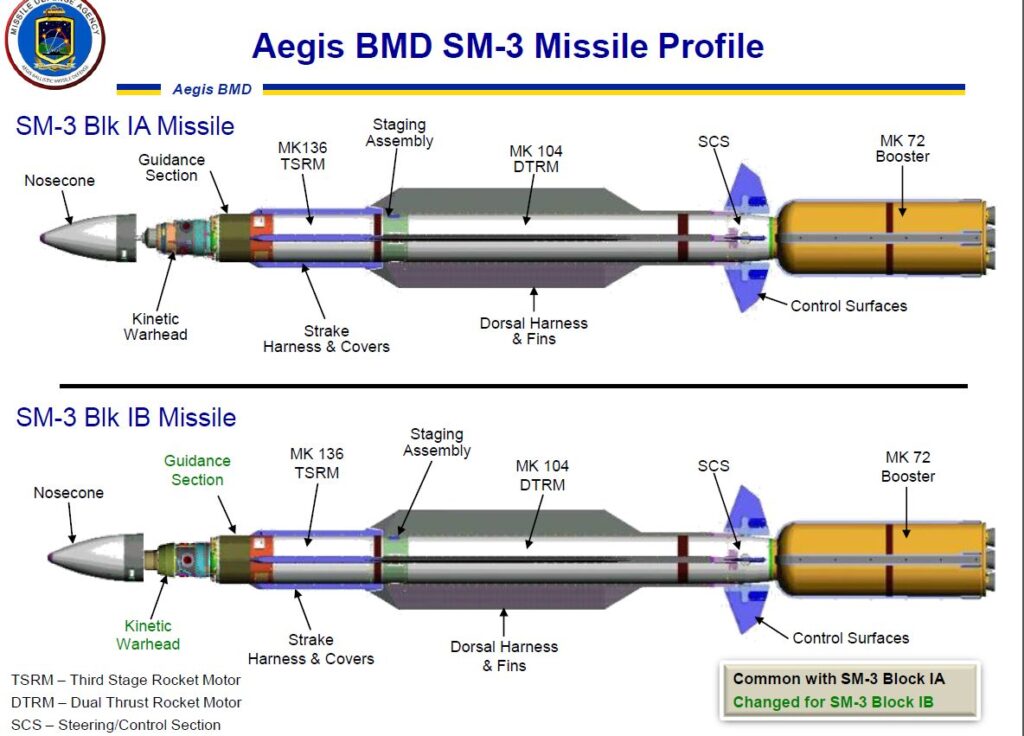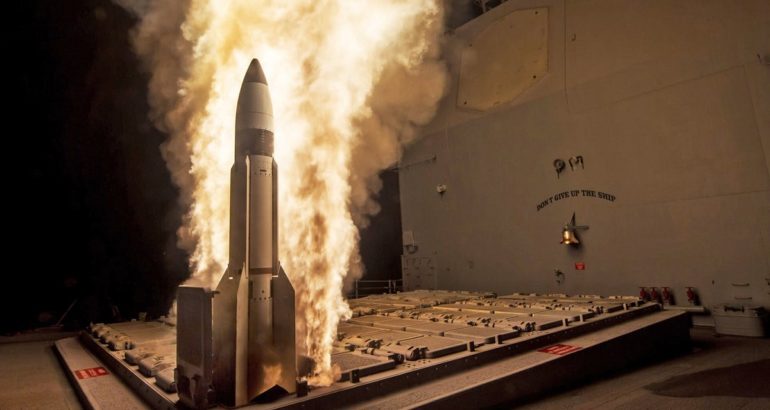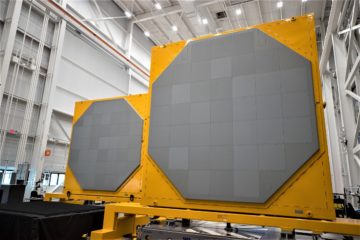Raytheon press release
“The SM-3 Block IIA interceptor was developed in partnership with Japan, and it features a larger rocket motor and kinetic warhead that allow it to defend broader areas from long-range ballistic missile threats. Our strong cooperation with Japanese industry was essential to the development of this next-generation solution that can defeat complex threats around the world from sea and land.”
Tay Fitzgerald, President of Strategic Missile Defense at Raytheon Missiles & Defense
The SM-3 interceptor is a defensive weapon the U.S. Navy uses to destroy short- to intermediate-range ballistic missiles. The interceptor uses sheer force, rather than an explosive warhead, to destroy targets in space. Its “kill vehicle” hits threats with the force of a 10-ton truck traveling 600 mph. This technique, referred to as “hit-to-kill,” has been likened to intercepting a bullet with another bullet.
The SM-3 Block IIA interceptor’s kinetic warhead has been enhanced, improving the search, discrimination, acquisition and tracking functions, to address advanced and emerging threats. The missile intercepted an advanced ballistic missile threat in its first live target test in early 2017.
The SM-3 interceptor is a critical piece of the Phased Adaptive Approach for missile defense in Europe. The interceptor is being carried by U.S. Navy ships deployed off Europe’s coast and is now operational at a land-based site in Romania, further enhancing Europe’s protection.
About SM-3 interceptor

The Standard Missile-3 (SM-3) is a derivative of the RIM-156 Standard SM-2 Block IV missile, and is the interceptor component of the U.S. Navy theater ballistic missile defense system, called NTW-TBMD (Navy Theater Wide – Theater Ballistic Missile Defense). It is an upper-tier (exo-atmospheric) ballistic missile defense weapon designed to intercept short- to intermediate-range ballistic missiles in the midcourse and terminal phases of flight. The SM-3 was originally planned to complement the lower-tier SM-2 Block IVA until the latter was canceled in December 2001. However, modern Aegis software has allowed the SM-3 to work in cooperation with lower-tier SM-2 and SM-6 air defense missiles.
The SM-3 missile, designated RIM-161A, uses the basic SM-2 Block IVA airframe and propulsion, and adds a third stage rocket motor (a.k.a. Advanced Solid Axial Stage, ASAS, made by Alliant Techsystems), a GPS/INS guidance section (a.k.a. GAINS, GPS-Aided Inertial Navigation System), and a LEAP (Lightweight Exo-Atmospheric Projectile) kinetic warhead (a non-explosive hit-to-kill warhead). The SM-3 interceptor replaced the SM-2’s explosive warhead and radar seeker with an additional solid-fueled third-stage motor and infrared homing kinetic kill vehicle, otherwise known as a LEAP.
The LEAP uses a Forward Looking Infrared (FLIR) sensor to locate its target and was tested in 4-flight series called Terrier/LEAP from 1992 to 1995. These tests used modified Terrier and Standard Missile-2 missiles. Two intercepts were attempted during these tests, but the LEAP failed to hit the target in both cases. The first flight test of a RIM-161A SM-3 missile occurred in September 1999, and the third test (in January 2001) demonstrated successful missile flight and control up to fourth stage (i.e. kinetic warhead) separation. In January 2002, the first all-up test of an SM-3 succeeded in intercepting an Aries ballistic target missile. For up-to-date information on testing, see the “U.S. Missile Defense Intercept Test Record” section of our website. SM-3 has successfully achieved 28 out of 36 intercepts during tests including the satellite shootdown in February 2008.
SM-3 Variants

- SM-3 Block I This SM-3 variant was a limited production version that provided the first operational Aegis BMD intercept capability in 2005 when the USS Lake Erie conducted an intercept test. Only eleven were built, and four of these were used during tests.
- SM-3 Block IA The Block IA variant of the SM-3 is designed to intercept short- and intermediate-range ballistic missiles, incorporating rocket motor upgrades and computer program modifications to improve sensor performance and missile guidance and control. The Block IA is the first production version of the SM-3, being deployed on the USS Shiloh in 2006 as part of the Aegis BMD 3.6 deployment. The SM-3 Block IA interceptor is employed by Aegis BMD 3.6 vessels.
- SM-3 Block IB This SM-3 variant became operational in 2014 and has an enhanced two-color infrared seeker and upgraded steering and propulsion capability that uses short bursts of precision propulsion to direct the missile towards incoming targets. The new two-color sensor provides the capability to sense infrared information in two distinct wavebands, improving the identification of multiple objects. A throttleable Divert Altitude Control System (TDACS) provides the SM-3 IB with more post-launch maneuverability than its predecessors. Overall, the Block IB variant is capable of engaging ballistic missile targets at longer ranges with increased threat discrimination and is equipped with Aegis BMD 4.0 vessels.
- SM-3 Block IIA This SM-3 variant is being jointly developed and tested by the United States and Japan and is expected to be deployed operationally and equipped by the sea- and land-based Aegis BMD 5.1 systems in 2018. The interceptor will have new second and third rocket stages, allowing it to travel at much higher speeds than Block I missiles. Although the Block IIA is designed to counter short- to intermediate-range threats, the missile’s enhanced speed provides it with a limited capability against Intercontinental-range ballistic missiles as well. The Block IIA will have a new kill vehicle with heightened seeker sensitivity, increased divert capability, and a longer operating time once released from its booster rocket. Although it is still in the testing phase, Phase III of the European Phased Adaptive Approach calls for the employment of the SM-3 Block IIA in Europe by 2018.






